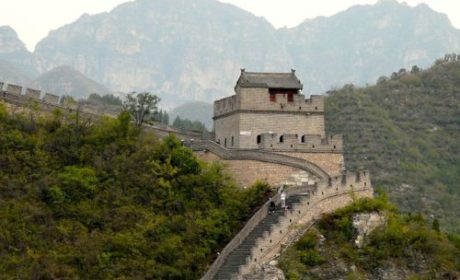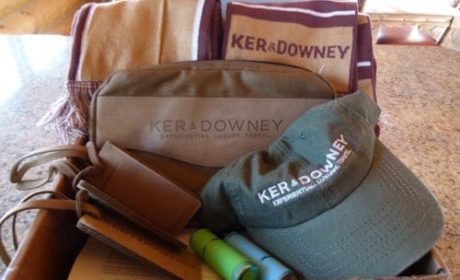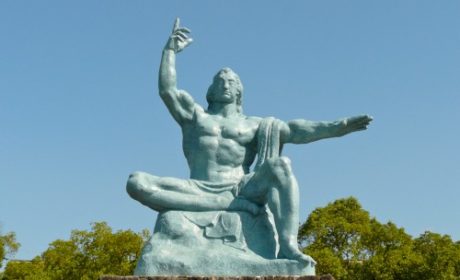Simply put—Japan is an amazing destination. From a strong cultural reverence for nature and order to the ultra high tech industry, the country has a bit of everything.
Planning a first-time visit to Japan can seem overwhelming. Never fear. Featured contributor, Debi Lander from ByLanderSea, is here to share her impressions and tips so that you’ll know what to expect.
I wasn’t expecting a last minute invitation to a tourism Expo in Japan. Would I go? Of course! A week later I was on the plane.
After the long flight to Tokyo, the ease of the Passport Control process came as a relief. Without a doubt, the Japanese strive for efficiency, and here they succeed.
I zipped through the lines with no delay. Thankfully, important signage appears in English. While picturesque, the written word in Japanese is unreadable.

Next stop, the restroom. Not your ordinary topic of conversation, but this was a notable experience.
I sat down to a warmed seat accompanied by the sounds of a gentle waterfall. The Japanese apparently feel the need to mask bathroom’s noises.
Not stopping there, the toilet’s sophistication extended to a rinse and blow dry choice. Seriously fastidious, the Japanese offer these high-tech toilets everywhere on the island nation. Quite lovely!
Boomer Travel Tip
MedjetAssist Members who are hospitalized 150 miles from home receive medical transport to a home-country hospital of choice. Memberships from $99.
Table of Contents
Staying at The New Otani in Tokyo

Exhausted from a long trip and the 13-hour time difference, I fell into a comfortable bed (without exotic options) at the Hotel New Otani after an hour-long bus ride from the airport. Next morning, breakfast offered a plethora of choices from soup, to raw vegetables and salad, all sorts of noodles and a variety of dumpling-like puffs.
Knowing I would spend the day at the convention center, I chose what was labeled “Japanese Omelet.” The dish contained layers, the top looking like a typical omelet, the under layers offering slightly undercooked scrambled eggs.
The hotel brewed American style coffee, but refills aren’t automatic. You must ask for a second cup.
The dining room overlooked a magnificent Japanese garden graced by a cascading waterfall. Its lure pulled me outside to a dry landscape rock garden, surrounded with carefully placed stones and raked gravel.
The rock path, reminiscent of a labyrinth walk, led to a red lacquered bridge over a large koi pond. About 350 colorful koi, the biggest I’d ever seen, added life to the magical setting.
Each section of the delicate garden demanded a photo, every step revealing a delight concealed just a moment before. The manicured plots featured painstaking design and maintenance.
I meandered past stone lanterns and statues, nestled beneath overhanging branches and shrubs. I strolled by a pathway leading to a pagoda and a teahouse. I descended until I gazed upwards at the 20-foot waterfall.

Lost in the moment, I contemplated the serene environment and the extraordinary fact that I was in Japan. (I later read that the 10-acre garden has flourished here for more than 400 years, the property of former samurai lords.)
Three days of meetings at the Expo kept me from exploring much of Tokyo except the views offered through my bus window. Roads ran at odd angles, not in a grid-like pattern. The cleanliness and lack of litter in the city was extraordinary.
I also learned firsthand that the Japanese emphasis on the orderly includes timely, well-organized meetings. The Japan National Tourism Organization aims to increase tourism as the look to presenting a spectacular Olympics in 2020. What I saw says they’ll succeed.
Exploring Tokyo for the first time

On the afternoon of the third day, two new friends from the Expo and I finally escaped the confinement of the meetings. We hailed a taxi to venture downtown, starting in the Ginza District, the home of fashion and luxury shopping. Every high-end company maintains a presence here, in equally lavish skyscrapers.
The majority of women shoppers wore dresses and high heels, no cutoffs or casual jeans. For men, business attire was the order of the day. As a tourist, I felt underdressed in my comfortable shoes and basic travel outfit.

The main thoroughfare was closed to traffic, a Saturday thing that made crossing the street easy. We entered a huge department store to visit the Food Halls, called depachikas.
Oh, my goodness! The displays and counters of glorious fruits and vegetables produced a jubilee-like aura, with plump, colorful edibles beckoning from artfully packaged containers fit for a king.
Creative, mouth-watering candy and confections case stole the show. Intricate chocolate animals, marzipan sculptures, and truffles abounded. I tried to take photos but was asked to put my camera away.

The butcher shop displayed authentic Kobe Beef marbled to perfection. The fish section flaunted exotic species that I can’t describe.
Overall, the prices seemed exorbitant—a single apple at $6 and a melon about $90, but I’s guess most folks were buying food as gifts or for a special occasion. I left feeling that the culture values quality food and in general, healthy diets.

Back on the street, people watching captivated my interest, that is until I came to the Mikimoto Pearl Store. I stopped and longingly gazed into the eye-catching window full of strands of stunning pearls as lustrous as silk and satin. I didn’t feel comfortable enough to go in, so had to settle for window-shopping.
Checking out the hip and happening Shibuya district

Tokyo, an immense city, covers 845 square miles holding some 14 million inhabitants. We decided to hire another taxi to save time finding the trendy Shibuya area, known as the party town. Boutique shops, department stores, restaurants, coffee shops, arcades and nightclubs overfill the congested streets.
Shibuya beats to a hip vibe and appears like Times Square on steroids. Behemoth neon signs play like video games, bouncing about the buildings and lighting up the district. Energy blazes from shop windows and between throngs of people young and old.
Of interest to Boomers: According to data from The World Factbook, 41 percent of Japanese people are over the age of 55, and nearly 30 percent are over the age of 65. In some parts of the country, young people are abandoning village life for the city, shifting large portions of the younger demographic to the already crowded cities.
As the domestic travel markets continue to decline due to aging, the need to develop and plan for a sophisticated international market emerges.
Standing on a corner, I became entranced by the mob waiting to cross the main intersection. Upon the go-ahead signal, their movement in unison resembled an army advancing in tight formation toward one another. When the two sides met in the middle, space miraculously opened, and the crowd crisscrossed seamlessly.
By the time the lights changed, nearly everyone had made it to the opposite side, and the crossroads stood empty for the briefest moment. Then, cars and buses whizzed out of nowhere, and the process repeated itself.
My friends and I ate dinner at a casual restaurant below street level. Taking the suggested choice of a pancake rolled around vegetables and chicken, I found it spicy but without burning heat. We drank the local brew, Kirin, on tap.
Afterward, we stopped into a wildly loud store, named Don Quijote or Donki as the locals say, stacked ceiling-high with cosmetics, food and snacks along with every known gadget and small appliance. Things you never knew anyone wanted or needed. Video games and cartoon characters loomed hugely popular.
I restrained myself (one of the few in the store), from purchasing anything, perhaps because my head was spinning from the digital blitz and bustle. I was ready to head back to the quiet respite of my hotel.
Including Hokkaido on a fist-time trip to Japan

The next morning, I joined a group flying to Hokkaido, the northernmost island of Japan.
Volcanic mountains, lakes and valleys cover Hokkaido, the isle where Sapporo, the largest city reigns as the capital. Boomers may recall it as the site of the 1972 Winter Olympics.
After landing, a shuttle bus transported my group to a gondola area where we zipped to the top of the mountain. Stunning views and an artistic and tasteful lunch waited.
All food, be it Japanese or Western, comes creatively arranged. Artful plating must be ingrained in Japanese DNA.
I drove past the grounds of the Sapporo Winter Festival, internationally renowned for imaginative ice sculptures. That evening we went to the Sapporo Beer Garden and Museum for the local specialty: a Genghis Khan meal or Mongolian BBQ.
The dinner included mutton and vegetables grilled by diners on a convex burner in the middle of the table. My group’s meal added some seafood.
The famous beer tasted like an American pale lager, and the lively atmosphere fired the night. The mutton was not my favorite. However, a lovely kimono-dressed woman, who seemed to float into the room and magically cut designs from paper, mesmerized me.
I ended my day with an overnight stay at Keio Plaza Hotel Sapporo.
Day Two in Hokkaido featured a chef who prepared traditional sushi and sashimi from the freshest fish. I’d been trying my best to use chopsticks, but was told that it is perfectly acceptable to eat sushi with your fingers. Hooray!

Every meal arrives tableside in an array of small dishes, sometimes eight to ten or more per person. Hot oolong tea compliments the seafood. If you like sushi, Japan should be on your bucket list.
We drove on to the Nikka Distillery, producers of Japanese Whisky (no ‘e’ as the Scottish spell it). The factory founder went to Scotland to study in 1918, returned with a Scottish wife, and became known as the Father of Japanese Whisky.

The buildings look something like those in Scotland, definitely not Japanese. The whisky had the familiar taste of scotch and its warmth to mouth and throat. The popularity of Japanese whisky has lately been soaring in the spirits world.
Staying the night in Niseko
Last stop on my quick tour was the Niseko Ski Resort, known as the St. Moritz of Japan. An alpine village rests at the bottom of several ski hills. The gondola entrance lies just steps from the Hilton Niseko Village lobby—my accommodations for the night—,making it extremely convenient for guests.
No white stuff in September, but I was told by Deana Saukam, a US citizen who previously skied Niesko, that the snow is “feather-like powder and excellent for skiing.” Americans are discovering the site’s blanketing of 580 inches a year leaves it with twice as much powder as most resorts in North America.
Onsen Bathing for a Japan first-timer
For me, the best part of the lovely Hilton was the Japanese hot mineral springs baths or onsen. I simply had to experience the traditional custom, even if I was a bit hesitant and self-conscience.

My guide explained that I’d find a yukata or lightweight robe for the onsen in my room. Wear it, with nothing underneath, to the ladies locker room.
Take a washcloth, brought from your room, to the shower area and thoroughly cleanse. I mentioned the Japanese regale cleanliness, and while I scrubbed and rinsed, I believe some of the women washed for more than 20 minutes.
Then, I walked naked outside, slightly covering myself with the washcloth, down a flight of steps, and into the single-sex only hot springs. Steam was rising as I sank into the warmth and gazed upon the beautifully illuminated and discreetly landscaped trees nearby. The heavenly soak and views created a calming environment, with no loud talking.
Lounging in this bath was the most glorious moment of my trip, and I could have stayed much longer, but my body grew hot. I climbed out and once again hit the showers to rinse off the minerals, put my yukata back on and return to my room.
My skin felt sensational. Onsen baths survive as a time-honored tradition. Don’t miss one if you are lucky enough to go to Japan.
How to plan your first-time visit to Japan
Trip planning is always easier with a few handy tools. Here are our favorites for planning your first-time trip to Japan.
- Compare flight schedules and prices at Kayak.
- Read the reviews at TripAdvisor before booking your room.
- Looking for a guided tour for the day? You’ll find plenty of experiences at Get Your Guide.
While visiting Japan, don’t miss these experiences:
- Discover a sobering history lesson on a Nagasaki shore excursion.
- Enjoy the Japanese countryside while biking the Kibiji Trail.
- Read tips for visiting Nara.
- Learn how to be your own tour guide when you visit Japan.



